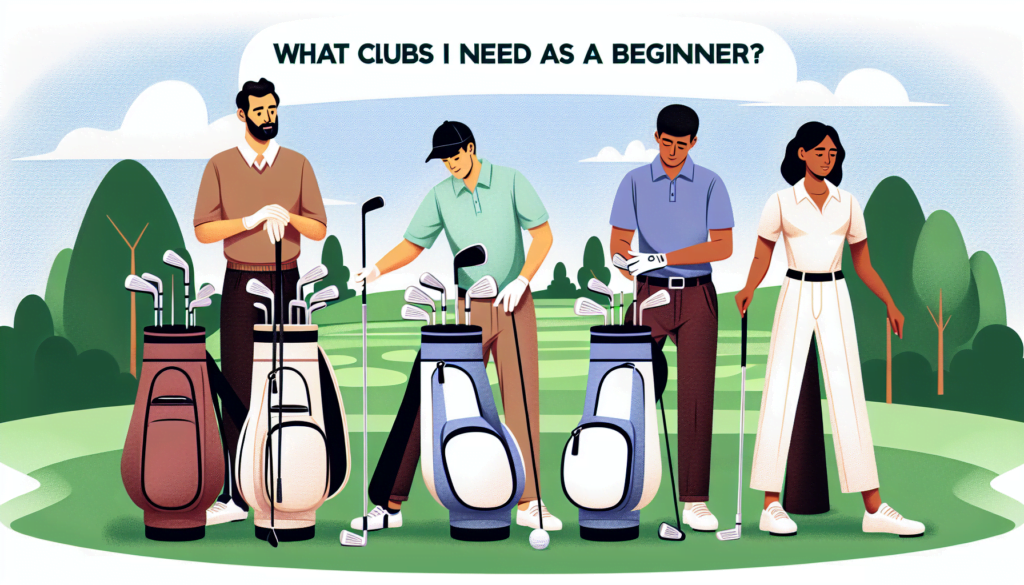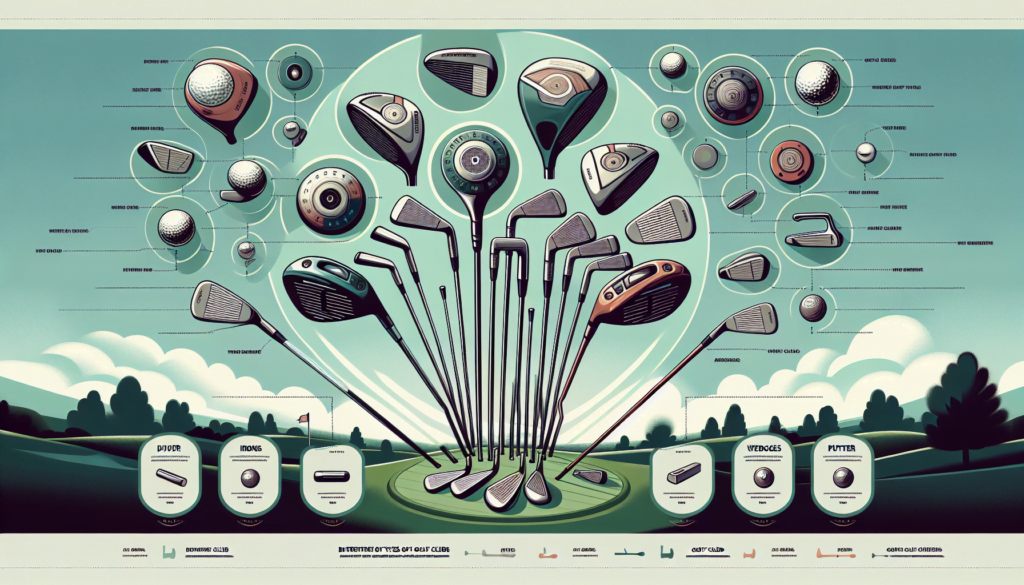If you’re new to golf and eager to step onto the green, you may find yourself asking that age-old question: “What clubs do I need as a beginner?” Luckily for you, ClubhouseLegends is here to provide all the answers and guidance you need to get started in this exciting sport. From explaining the different clubs and their purposes to offering tips on how to improve your game, this comprehensive resource has got you covered. Not only that, but they also provide reviews on products and accessories to help you make informed decisions when it comes to purchasing the necessary equipment. So, whether you’re teeing off for the first time or looking to refine your skills, let ClubhouseLegends be your trusted companion in your golfing journey.
1. Woods
When it comes to golf clubs, woods are typically used for longer shots and are designed to give you distance and accuracy off the tee. The most commonly used wood is the driver, which is often the first club in a golfer’s bag. The driver is specifically designed to hit the ball the farthest, with a larger clubhead and longer shaft than other woods.
1.1 Driver
The driver is often seen as the most exciting club in a golfer’s bag, as it allows you to hit the ball a considerable distance off the tee. The driver is also the most difficult golf club to hit because it is the longest in length and feels heavy during the swing. It’s important to choose a driver that suits your swing and skill level, as different drivers have different levels of forgiveness. Take into consideration factors like head size, loft, and shaft flex when selecting a driver that works best for you.
1.2 Fairway Woods
Fairway woods are similar to drivers but have smaller clubheads and shorter shafts. These clubs are often used for shots from the fairway or tee when a driver is too much club. Fairway woods provide a good balance of distance and control, making them a versatile choice for many golfers.
2. Irons
Irons are the most versatile clubs in a golfer’s bag, used for a wide range of shots from the fairway, rough, or even off the tee depending on the situation. Irons are numbered from the lower lofted clubs to the higher lofted clubs, with the lower numbered irons designed for longer shots and the higher numbered irons designed for shorter, more controlled shots.
2.1 Pitching Wedge
The pitching wedge is generally the highest lofted iron in a golfer’s bag and is used for shorter approach shots to the green. It is designed to get the ball in the air quickly and land softly on the green.
2.2 Sand Wedge
The sand wedge is specifically designed to help golfers escape bunkers and get their ball out of the sand. It has a higher loft than other irons and a wider sole, which helps prevent the club from digging into the sand.
2.3 9 Iron
The 9 iron is another versatile iron that can be used for a variety of shots. It has a higher loft than the pitching wedge, making it useful for shorter approach shots or shots around the green where more height and spin are desired.
2.4 8 Iron
The 8 iron is one of the mid-irons and can be used for longer approach shots if you need more distance. It provides a good balance of control and distance for many golfers.
2.5 7 Iron
The 7 iron is another mid-iron that provides even more distance than the 8 iron. This club is often used for approach shots or shots that require a combination of distance and control.
2.6 6 Iron
Moving down the set, the 6 iron is another mid-iron that offers even more distance than the 7 iron. It can be used for longer approach shots or shots where you need more carry.
2.7 5 Iron
The 5 iron is a longer iron that is typically used for approach shots requiring even more distance. It can be a challenging club to hit for beginners due to its lower loft and longer shaft.
2.8 4 Iron
The 4 iron is the longest iron in a standard iron set. It is designed for maximum distance and is often used for longer approach shots or tee shots on par 3 holes.
2.9 3 Iron
The 3 iron is the longest iron that is still commonly found in golfers’ bags. It is designed for maximum distance but can be challenging to hit due to its low loft and long shaft.

3. Hybrids
Hybrids are a relatively newer addition to golf clubs and are designed to blend the characteristics of woods and irons. They feature a clubhead similar to a fairway wood but with a shorter shaft and more loft, making them easier to hit than long irons. Hybrids are often used as a replacement for long irons to provide more forgiveness and distance.
4. Wedges
Wedges are specialty clubs that are designed to provide precise distance control and versatility around the green. They have higher lofts than irons, allowing you to hit the ball high and land it softly.
4.1 Gap Wedge
A gap wedge, also known as an approach wedge, is typically used for shots where the distance is too long for a pitching wedge but too short for a sand wedge. It fills the “gap” in distance between these two clubs.
4.2 Lob Wedge
The lob wedge has the highest loft of any club in the bag and is used for shots that require a high, soft landing with very little roll. It is often used for shots over hazards or when you need to hit the ball high and stop it quickly.

5. Putters
The putter is arguably the most important club in a golfer’s bag, as it is used on the green to roll the ball into the hole. Putters come in a variety of shapes and sizes, and the right putter for you will depend on your personal preference and putting style.
6. Full Golf Club Sets
Full club sets typically include a variety of woods, irons, wedges, and a putter. These sets are designed to provide a range of clubs that cover different distances and shots. They are often a good option for beginners or golfers looking to upgrade their entire set of clubs.
7. Individual Club Selection
Selecting the right individual clubs for your bag depends on a variety of factors.
7.1 Assessing Skill Level
Consider your skill level when choosing clubs. Beginners may benefit from a more forgiving club with a larger sweet spot, while more advanced players may prefer clubs with more workability and control.
7.2 Physical Abilities and Swing Speed
Take into account your physical abilities and swing speed. Players with slower swing speeds may benefit from clubs with more forgiveness and higher launch angles, while players with faster swing speeds may prefer clubs with more control and lower launch angles.
7.3 Course Conditions
Consider the typical course conditions you play on. If you often play on courses with narrow fairways or challenging rough, clubs that provide more forgiveness and accuracy may be beneficial. Conversely, if you play on wide-open courses, distance may be a higher priority.
7.4 Budget
Lastly, consider your budget. Golf clubs can range in price, so it’s important to find clubs that fit within your budget while still providing the performance you desire.
8. Club Fittings
Club fittings are an important step in finding the right clubs for your game.
8.1 Purpose and Importance
The purpose of a club fitting is to ensure that your clubs are properly suited to your swing and physical characteristics. A proper club fitting can maximize distance, accuracy, and consistency, ultimately improving your overall game.
8.2 Professional Golf Club Fitting
For the most accurate and personalized club fitting experience, it is recommended to visit a professional club fitter. These experts will analyze your swing, take measurements, and use advanced technology to recommend clubs that are specifically tailored to your unique needs.
9. Borrowing and Renting Golf Clubs
If you’re just starting out or don’t play golf regularly, borrowing or renting clubs can be a cost-effective option.
9.1 Benefits of Borrowing or Renting Clubs
Borrowing or renting clubs allows you to try out different brands and models before committing to a purchase. It also saves you from the upfront investment of buying a full set of clubs.
9.2 Considerations when Borrowing or Renting Clubs
When borrowing or renting clubs, it’s important to consider the condition of the clubs and ensure they are suitable for your skill level. Additionally, be mindful of any rental fees or restrictions that may apply.
10. Clubhead Material and Design
The material and design of the clubhead can impact how the club performs and feels.
10.1 Titanium and Stainless Steel
Titanium and stainless steel are commonly used materials for clubheads. Titanium is lightweight and strong, allowing for larger clubhead sizes and increased forgiveness. Stainless steel offers durability and a solid feel, but typically with smaller clubheads and less forgiving characteristics.
10.2 Clubhead Design
Clubhead design plays a role in factors such as forgiveness, workability, and distance. Different designs, such as cavity-back or muscle-back irons, offer varying levels of forgiveness and control. It’s important to consider your skill level and preferences when selecting a clubhead design.
In conclusion, choosing the right golf clubs is crucial to your performance on the course. Whether you’re a beginner or a seasoned golfer, understanding the different types of clubs and their purposes will help you make informed decisions when building your golf bag. Consider your skill level, physical abilities, course conditions, and budget when selecting clubs, and don’t forget the importance of club fittings to ensure a proper fit. Happy golfing!
